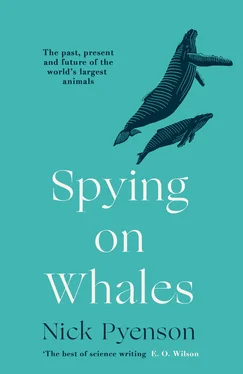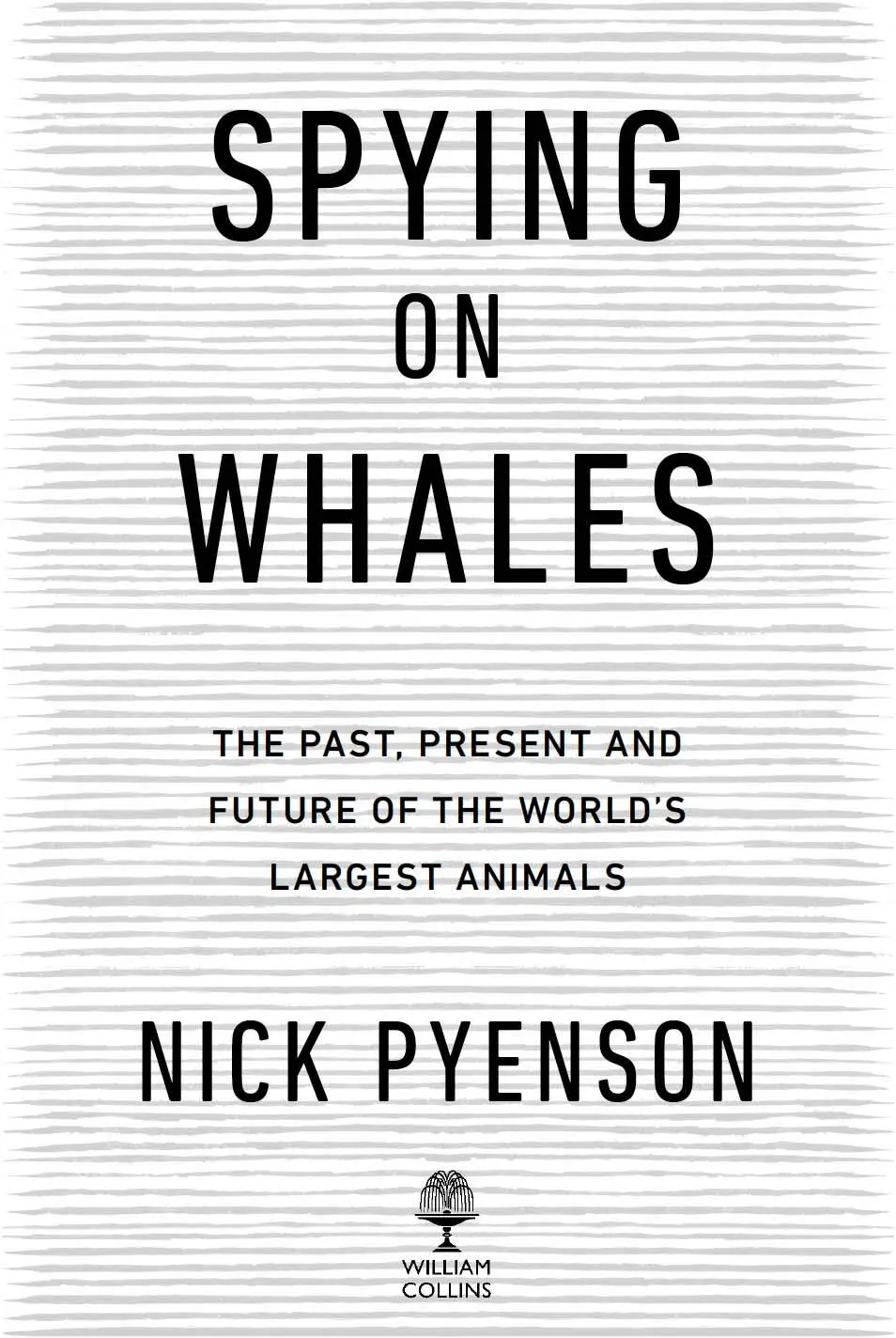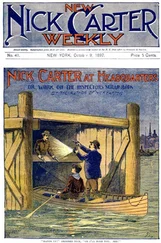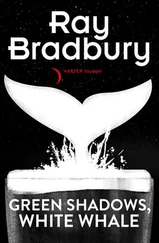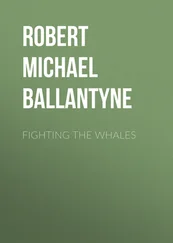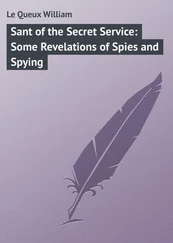William Collins
An imprint of HarperCollins Publishers
1 London Bridge Street
London SE1 9GF
WilliamCollinsBooks.com
This eBook first published in Great Britain by William Collins in 2018
Copyright © 2018 by Smithsonian Institution
Design by Anna Morrison; Illustrations by Alex Boersma
First published in the United States of America by Viking, an imprint of Penguin Random House LLC in 2018 as Spying on Whales: The Past, Present, and Future of Earth’s Most Awesome Creatures
The author asserts the moral right to be identified as the author of this work.
A catalogue record for this book is available from the British Library.
All rights reserved under International and Pan-American Copyright Conventions. By payment of the required fees, you have been granted the non-exclusive, non-transferable right to access and read the text of this e-book on-screen. No part of this text may be reproduced, transmitted, down-loaded, decompiled, reverse engineered, or stored in or introduced into any information storage and retrieval system, in any form or by any means, whether electronic or mechanical, now known or hereinafter invented, without the express written permission of HarperCollins.
Source ISBN: 9780008244460
Ebook Edition © June 2018 ISBN: 9780008244484
Version: 2019-04-18
Every author writes with a very specific reader in mind.
I wrote this book for you.
And for my family.
What have we been doing all these centuries but trying to call God back to the mountain, or, failing that, raise a peep out of anything that isn’t us? What is the difference between a cathedral and a physics lab? Are not they both saying: Hello? We spy on whales and on interstellar radio objects; we starve ourselves and pray till we’re blue.
— Annie Dillard, Teaching a Stone to Talk
For the animal shall not be measured by man. In a world older and more complete than ours, they move finished and complete, gifted with the extension of the senses we have lost or never attained, living by voices we shall never hear. They are not brethren, they are not underlings: they are other nations, caught with ourselves in the net of life and time, fellow prisoners of the splendour and travail of the earth.
— Henry Beston, The Outermost House
Contents
Cover
Title Page
Copyright
Dedication
Epigraph
Map
Prologue
PART I:PAST
1. How to Know a Whale
2. Mammals Like No Other
3. The Stories Bones Tell
4. Time Travel on the Fossil Whale Highway
5. The Afterlife of a Whale
6. Rock Picks and Lasers
7. Cracking the Case of Cerro Ballena
PART II:PRESENT
8. The Age of Giants
9. The Ocean’s Utmost Bones
10. A Discovery at Hvalfjörður
11. Physics and Flensing Knives
12. The Limits of Living Things
PART III:FUTURE
13. Arctic Time Machines
14. Shifting Baselines
15. All the Ways to Go Extinct
16. Evolution in the Anthropocene
17. Whalebone Junction
Epilogue
A Family Tree of Whales
Notes
Selected Bibliography
Index
Acknowledgments
About the Publisher

At this very moment, two spacecraft move at over thirty-four thousand miles per hour, about ten billon miles away from us, each carrying a gold-plated copper record. The spacecraft, Voyager 1 and Voyager 2 , are meant as messengers: they carry information about our address in the solar system, the building blocks of our scientific knowledge, and a small sampling of images, music, and greetings from around the world. They also carry whalesong.
The long squeaks and moans on the record belong to humpback whales. In the 1970s, when the Voyager mission launched, our view of whales was rapidly changing, from game animals to cultural icons and symbols of a nascent environmental movement. Scientists had recently discovered that male humpbacks produce complex songs, composed of phrases collected under broader themes, nested like Russian dolls that repeat in a loop. Humpback whalesong has evolved even since we started listening as each new singer improvises on the loop, creating new structures and hierarchies that constantly change over years, and across ocean basins.
Whalesong, however, remains a riddle to anyone who isn’t a humpback whale. We can capture its variation, details, and complexity, but we don’t know what any of it truly means. We lack the requisite context to decipher and understand it—or, really, any part of cetacean culture. Even so, we send whalesong into interstellar space because the creatures that sing these songs are superlative beings that fill us with awe, terror, and affection. We have hunted them for thousands of years and scratched them into our mythologies and iconography. Their bones frame the archways of medieval castles. They’re so compelling that we imagine aliens might find them interesting—or perhaps understand their otherworldly, ethereal song.
In the meantime, whales here on Earth remain mysterious. They live 99 percent of their lives underwater, far away from continuous contact with people and beyond most of our observational tools. We tend to think about them only when we glimpse them from the safety of a boat, or when they wash up along our shores. They also have an evolutionary past that is surprising and incompletely known. For instance, they haven’t always been in the water. They descend from ancestors that lived on land, more than fifty million years ago. Since then, they transformed from four-limbed riverbank dwellers to oceangoing leviathans, in a chronicle we can read only from their fossil record, a puzzle of bone shards unevenly spread across the globe.
The little we have learned about whales leaves us unsatisfied because the scales of their lives and facts of their bodies are endlessly fascinating. They are the biggest animals on Earth, ever. Some can live more than twice as long as we do. Their migrations take them across entire oceans. Some whales pursue prey with a filter on the roof of their mouth, while others evolved the ability to navigate an abyss with sound. And then they speak to one another with impenetrable languages. All the while, in the short clip of our own history, we’ve moved from heedlessly hunting them to an awareness that they have culture, just as we do, and that our actions, both direct and indirect, put their fate in jeopardy.
A paleontologist is a good tour guide for what we know about whales, not just because their evolutionary history is profoundly interesting. It’s because we, as paleontologists, are used to asking questions without having all of the facts. Sometimes we’re losing facts: fossils removed from their medium lose clues of context; promising bonebeds are razed to make room for roadways; or bones lay misidentified in a museum drawer. When faced with these challenges, paleontologists turn to inference, drawing on many different lines of evidence to understand processes and causes that we cannot directly see or study—the same approach used by any detective, really. In other words, thinking like a detective is a useful approach to confront the mysteries posed by the past, present, and future of whales.
Читать дальше
